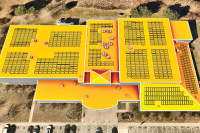Cases surge with Omicron arrival

The arrival of the extremely contagious Omicron variant in conjunction with holiday travel and gatherings has caused a spike in COVID-19 cases far eclipsing anything seen in the pandemic to date — but the variant’s apparently milder effects compared to previous COVID-19 strains could a limited impact.
"The omicron variant is certainly leading to both an increase in cases and in hospitalizations in our community,” said William Hathaway, Chief Medical Officer for Mission Health System. “Fortunately, all evidence to date suggests that this variant, while more contagious than prior variants, appears to cause less significant disease in those it infects.”
After staying between 3,000 and 5,000 in the weeks between Christmas and Thanksgiving, North Carolina’s daily case counts began to climb in the days preceding Christmas and then spiked to an all-time high of 19,620 Jan. 1, with counts remaining above 12,000 every day since Dec. 30. Prior to this most recent spike, the largest single-day tally for new COVID-19 cases was on Feb. 3, 2021, with 12,079 cases. The skyrocketing cases are causing staffing issues in a variety of sectors as employees are forced to quarantine.
In response to the skyrocketing case counts, Principal Chief Richard Sneed on Jan. 3 announced a slate of new protective measures effective through Jan. 30. They include masking requirements and limited in-person meetings for tribal employees, a four-day workweek option for government offices, redefining “fully vaccinated” to include a booster shot, and prioritizing who will receive COVID-19 tests in recognition of staffing shortages at the Cherokee Indian Hospital.
“Eastern Band of Cherokee tribal citizens are naturally a very social and family-oriented people, and as such the holiday season brought about a time for joyful gatherings with families, friends and loved ones,” said Sneed. “Unfortunately, the increased personal interaction, coupled with a surge of positive COVID-19 cases regionally and nationally, has increased the number of positive COVID-19 cases on the Qualla Boundary and surrounding communities.”
As case counts have risen, so have hospitalizations — though thus far not nearly to the extent they did during earlier surges, when case counts were much lower. As of Jan. 2, 2,772 people statewide were hospitalized with COVID-19. After Christmas last year, hospitalization numbers didn’t fall below 3,000 for a month, nearly breaking 4,000.
Related Items
Local hospitals are seeing the same trend. As of Jan. 4, Haywood Regional Hospital had 18 COVID-positive patients, and on Jan. 3 Harris Regional Hospital had fewer than 10. During the height of the pandemic, Harris was treating 25-30 COVID-19 patients at any one time, and HRMC had 20-25.
As of 4:30 a.m. Jan. 3, the Mission Health System had 106 COVID-positive patients, of whom 75 were at Mission Hospital in Asheville and seven at Angel Medical Center in Franklin. On Jan. 3 last year, Mission had 162 COVID-positive patients across its network.
The discrepancy could be partly due to the rapid onset of the Omicron wave. Cases have been surging for less than two weeks, with the more dramatic increase just days old — there is typically a lag between increased case counts, hospitalizations and deaths.
But it’s likely also has much to do with the milder illness that Omicron seems to be causing worldwide. In both South Africa and the United Kingdom, which Omicron hit earlier than the United States, the surge in cases did not cause any corresponding surge in deaths. Recent studies have indicated that Omicron does not infect the lungs like previous variants have, explaining the dearth of more serious symptoms.
It’s also possible that hospitalization numbers inflate the impact of COVID-19 as a driver for hospitalization. A Dec. 31 report from the U.K. National Health Service found that, of the 8,321 COVID-positive patients occupying a hospital bed on Dec. 28, only 5,578 — or 67% — were there primarily to be treated for the virus. In a Dec. 30 interview with MSNBC, Dr. Anthony Fauci discussed this phenomenon as it relates to children.
“If a child goes in the hospital, they automatically get tested for COVID, and they get counted as a COVID-hospitalized individual, when in fact they may go in for a broken leg, or appendicitis, or something like that,” he said. “So it's over-counting the number of children who are hospitalized with COVID as opposed to because of COVID.”
Despite the lesser number of COVID-19 patients compared to this time last year, area hospitals are still struggling to meet community needs. According to Dr. Ben Guiney, an emergency room physician at Harris, that’s primarily due to staffing issues.
“It’s because of the nursing shortage, but it’s also because nurses are now getting sick with COVID,” he said. “They’re not getting admitted to the hospital, but they can’t work for five days.”
As of Jan. 4, Harris was listing 89 job openings and HRMC had 164. That’s up from Nov. 2, when Harris listed 83 jobs and HRMC listed 136. The staff shortage, exacerbated by the Omicron surge and associated quarantine requirements, is interfering with the hospitals’ ability to see treat patients as quickly as is optimal.
“As WNC faces a critical bed shortage, it is imperative that we preserve the ER for those who are critically ill or in need of urgent medical care,” reads a Jan. 3 Facebook post from the Cherokee Indian Hospital. “Please do not use the ER if you are only mildly ill or need a test to travel or for work.”
Omicron’s onslaught is also evident in the large number of vaccinated people who are testing positive for the virus. In Haywood County Emergency Services’ weekly update sent Dec. 28, 93.2% of the past week’s new COVID cases were in unvaccinated people. However, in the Jan. 3 update the department reported that 61.3% of the past week’s 255 new COVID cases were in unvaccinated people. According to the N.C. Department of Health and Human Services, 44% of Haywood County residents are not vaccinated.
At this point, said Guiney, being vaccinated will not prevent infection but is still effective at preventing serious illness.
“The only people that are coming in the hospital, getting admitted to the hospital, getting sick, getting on ventilators, are unvaccinated people,” he said. “Vaccinated people are not staying in the hospital. It’s just that stark.”
Guiney, who has been vaccinated, boosted, and contracted COVID-19 in December 2020, before vaccines were available, used himself as a counterexample. He recently caught the virus again, but this time it was just a cough — in fact, the illness was so mild that at first he didn’t even consider that he might have COVID.
The Centers for Disease Control recently amended its isolation guidelines for COVID-positive people from 10 days to five days if symptoms are resolving, followed by five days of wearing a mask around others. The change is for the general public only, and the CDC will likely come out with amended guidelines for other settings.
Omicron’s high level of contagiousness has led many health experts to question the effectiveness of cloth masks in offering any meaningful protection against contracting or spreading the virus, and to recommend well-fitted, high-filtration masks instead. Anyone testing positive for the virus should reach out to friends and family who meet the close contact criteria and encourage them to self-quarantine or get tested five days after exposure.
Vaccines are now available for everybody 5 and older, with boosters available to people 16 and older once they’re six months past initial doses of Pfizer or Moderna, or two months past the initial dose of Johnson & Johnson.









